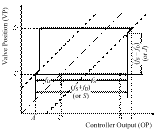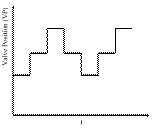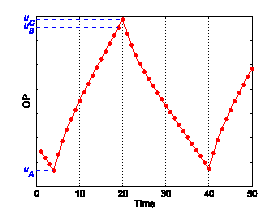285c Valve Stiction Detection and Quantification In Oscillatory Control Loops
Valve stiction is one of the most common equipment problems that cause poor performance in control loops. Consequently, there is a strong need in the process industry for non-invasive methods that can not only detect but also quantify stiction [1]. In our previous work [2], a data-driven valve stiction model is presented and a stiction detection method is proposed based on curve-fitting approach. Once valve stiction is detected, it is desirable to quantify the severeness of the stiction so that the right action can be taken – leaving it alone, compensating by control, or requiring immediate valve replacement.
In this work, we propose a noninvasive method to quantify the severeness of valve stiction using the routine operating data obtained from the process, i.e., process variable (PV) and controller output (OP). The algorithm is proposed to estimate the stiction parameters, namely static friction fS and dynamic friction fD, without requiring the valve position (VP) signal. Identification is accomplished by using linear and nonlinear least-squares methods which are robust and easy to implement. Several simulation examples, including both self-regulating and integrating processes with different degrees of stiction, are used to demonstrate the effectiveness of the method. In the simulation examples, we show that the proposed method is applicable to different stiction models, including the one we developed previously [2] and the one developed by Choudhury [3] and
The proposed method is based on the following observation: when a stable limit cycle caused by valve stiction is detected, the output of a sticky valve resembles a rectangular wave as illustrated in Fig.1; while the case shown in Fig. 2 will not occur after the limit cycle stabilizes. In other words, the valve jumps only once before it changes direction. Based on this observation, we can see that (fS + fD) or S (shown in Fig. 1 (a) and termed as the amount of apparent stiction [1]) is approximately the length of (|AB|+|AC|)/2, as |AB|≤ (fS + fD) and |AC|≥ (fS + fD); while (fS - fD) or J (shown in Fig. 1. (a) and termed as slip jump [3]) is approximately the length of |DE| which can be estimated based on measurements of PV. Because the location of O as shown in Fig. 1 (a) cannot be determined based on process data, the values of fS and fD cannot be estimated until the values of both (fS + fD) and (fS - fD) are estimated. By making use of both OP and PV measurements, valve stiction parameters can be estimated without requiring measurements of VP which is usually not available.
(a) (b) (a) (b) Fig. 1 Valve stiction with single jump: Fig. 2 Valve stiction with multiple jumps: (a) VP-OP plot; (b) VP-t plot (a) VP-OP plot; (b) VP-t plot · Estimation of (fS + fD): We use a self-regulating process to illustrate how to estimate (fS + fD) based on the measurements of OP. Fig. 3 shows the time series plot of OP when a sticky valve is present in the control loop. Fig. 3 OP measurements of a self-regulating process with a sticky valve By comparing Fig. 3 with Fig. 1 (a), the points (A, B and C) in Fig.1 (a) can be identified and marked correspondingly in Fig.3 and the estimate of (fS + fD) can be determined from the OP measurements by detecting peaks and valleys in the OP signal and we have For an integrating process, the estimation procedure of (fS + fD) is the same as that of a self-regulating process. The effects of noise and time delay on the estimate of (fS + fD) and their handling are discussed in detail. · Estimation of (fS - fD): For a self-regulating process, the process output (PV) can be approximated by a series of step responses. For a general FOPTD model, the step response is: where Kp is the process gain, (fS - fD) is the magnitude of the rectangular pulse/step input, where PV+ and PV– are upper and lower bounds of PV. For an integrating process, we show that where Notice that in the proposed method, both fS and fD (or S and J) can be estimated. In addition, the proposed method only requires limited process knowledge, i.e., estimated process gain and time delay, besides routine operating data OP and PV. Key words: stiction quantification; control valve; identification and estimation; fault diagnosis References: 
![]()



![]()

![]()
![]()


![]()
![]()